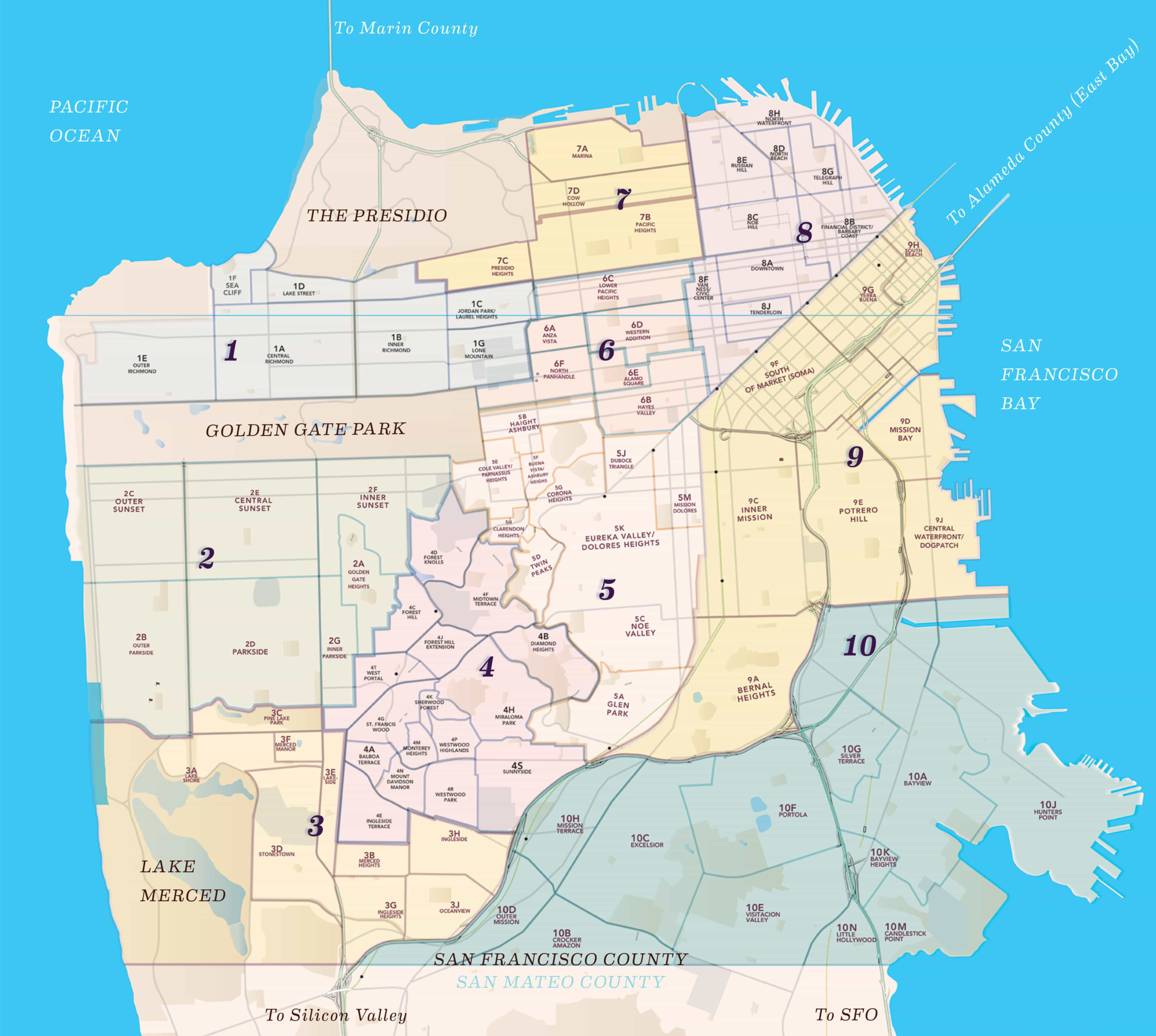
District 1: Northwest (Including Sea Cliff, Richmond, Jordan Park/Laurel Heights, and Lone Mountain)
District 2: Sunset (Including Sunset, Parkside, and Golden Gate Heights)
District 3: Southwest (Including Lakeshore, Lakeside, Merced Heights, Ingleside, Ingleside Heights, Merced Manor, and Oceanview)
District 4: West of Twin Peaks (Including St. Francis Wood, Forest Hill, West Portal, Miraloma Park, and Diamond Heights)
District 5: Central (Including Noe Valley, Castro, Glen Park, and Cole Valley)
District 6: Central North (Including Hayes Valley, NOPA, Alamo Square, and Western Addition)
District 7: North (Including Pacific Heights, Presidio Heights, Cow Hollow, and Marina)
District 8: Northeast (Including Russian Hill, Nob Hill, Telegraph Hill, North Beach, Financial District, and Downtown)
District 9: Southeast (Including SoMa, South Beach, Mission Bay, Potrero Hill, Dogpatch, Bernal Heights, Inner Mission, and Yerba Buena)
District 10: Southeast (Including Bayview, Excelsior, Visitacion Valley, Portola, Crocker Amazon, and Outer Mission)
District 1: Northwest (Including Sea Cliff, Richmond, Jordan Park/Laurel Heights, and Lone Mountain)
Overview:
District 1 is a peaceful, more laid-back part of San Francisco, located in the city’s northwest corner. It includes neighborhoods like Sea Cliff, Inner Richmond, Central Richmond, Outer Richmond, Jordan Park, and Laurel Heights. The area offers a mix of quiet, residential streets, vibrant commercial corridors, and proximity to some of the best parks in the city, including the Presidio and Lands End. It’s a popular district for those who want a suburban feel with easy access to nature and outdoor activities.
Architecture:
District 1 features a variety of architectural styles. Sea Cliff is known for its luxurious Mediterranean Revival and Tudor-style homes with stunning ocean views, while Richmond boasts a mix of Edwardian and Victorian single-family homes. Jordan Park and Laurel Heights feature larger, early 20th-century homes with spacious yards and more upscale aesthetics.
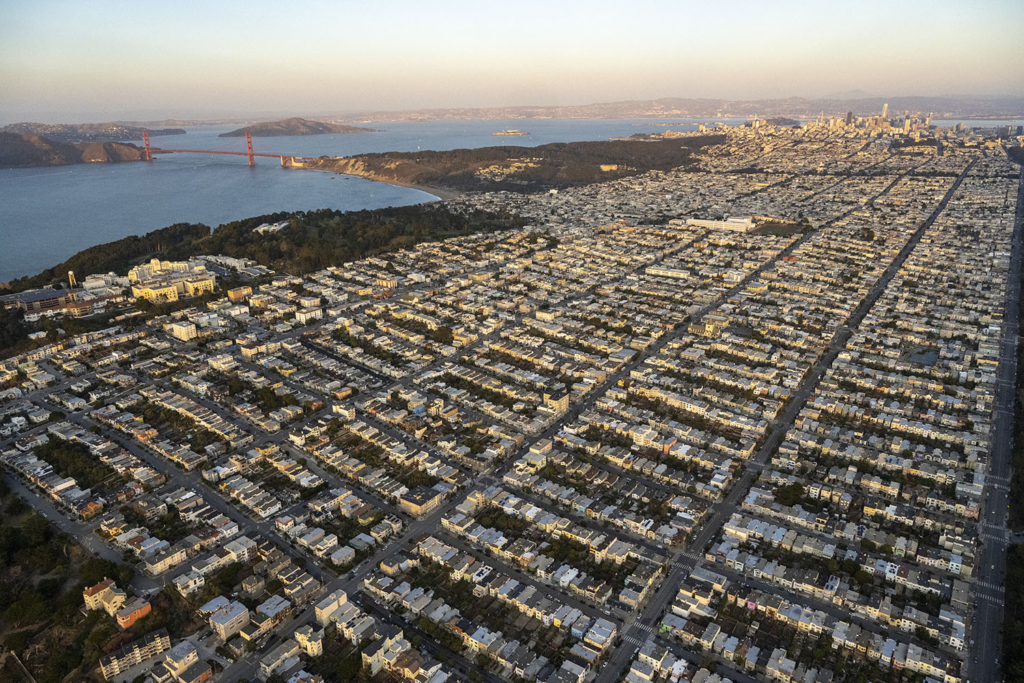
District 1: Northwest
History:
Much of District 1 was developed in the late 19th and early 20th centuries as San Francisco expanded westward. Sea Cliff became one of the city’s most exclusive neighborhoods, home to celebrities and prominent families. The Richmond District, originally known as “The Outside Lands,” transformed from sand dunes into a thriving residential area, while Jordan Park and Laurel Heights catered to wealthier residents seeking larger homes in the early 20th century.
Weather:
Due to its proximity to the Pacific Ocean, District 1 tends to be cooler and foggier than other parts of the city, especially in the summer. Fall often brings clearer skies and warmer days, but the district’s coastal climate offers a refreshing escape from the warmer, sunnier neighborhoods in central San Francisco.
Education:
District 1 is known for its strong private and public school options. Public schools like Lafayette Elementary, Argonne Elementary, and Presidio Middle School are highly regarded, while George Washington High School provides a solid public high school option. For private education, families can look to top-tier schools like San Francisco Waldorf School and St. Ignatius College Preparatory.
- Private Schools: San Francisco Waldorf School and St. Ignatius College Preparatory are popular private schools that offer a rigorous academic experience.
- Charter/Magnet Schools: KIPP San Francisco College Preparatory is a charter school available for families seeking a college-prep curriculum. There are no magnet schools in District 1.
Grade for Education: A-
(Strong public and private school options, though competition through the SFUSD lottery system can be a challenge.)
Public Transit, Walkability, and Proximity to Work Hubs:
District 1 is fairly well-connected by Muni bus lines, especially along major streets like California, Geary, and Clement. While parts of Inner Richmond and Laurel Heights are highly walkable, other areas are more car-dependent. For professionals in tech or healthcare, commuting to work hubs in SoMa or Mission Bay may take a bit longer, but public transit provides an easy connection.
Work-Life Balance:
Living in District 1 offers a perfect balance between work and outdoor recreation. Residents can enjoy the Presidio and Lands End for hiking and stunning views, while Clement Street and Geary Boulevard provide plenty of dining and nightlife options. The neighborhood’s peaceful atmosphere, combined with its proximity to parks and outdoor activities, makes it easy to relax and unwind after work.
Did you know?
- Sea Cliff is home to some of the most expensive real estate in San Francisco, with homes offering stunning views of the Golden Gate Bridge and Pacific Ocean.
- The Richmond District was once referred to as “The Outside Lands” because of its remote location before development.
- Lands End has hiking trails that lead to the ruins of the historic Sutro Baths, offering panoramic views of the coast.
Landmarks/Attractions:
- Lands End: A stunning coastal park with hiking trails and breathtaking views of the Golden Gate Bridge.
- The Presidio: A former military base that’s now a national park, offering beautiful trails and cultural events.
- Clement Street: A bustling commercial street in the Richmond known for its eclectic dining and shopping options.
Price per sq. ft.: $1,025 – $1,200 (2024 Q3)
Median price per sq. ft. for condos: $950 – $1,050
People who live here enjoy the neighborhood because:
District 1 attracts residents who love peaceful, residential living with easy access to nature. Families are drawn to the strong schools and proximity to parks, while professionals appreciate the quiet atmosphere and the lively restaurant scene along Clement Street. Whether you’re a nature lover or enjoy a suburban vibe within the city, District 1 offers the best of both worlds.
Subdistricts in District 1 (SFAR Nomenclature):
- Sea Cliff: An upscale neighborhood with grand homes and ocean views, offering a secluded and luxurious lifestyle.
- Price per sq. ft.: $1,325 – $1,475
- Lake Street: A quiet, residential street lined with classic Edwardians and Victorians, near the Presidio and Mountain Lake Park.
- Price per sq. ft.: $1,050 – $1,225
- Inner Richmond: A lively, walkable neighborhood with a mix of apartments and single-family homes, close to the commercial strips of Clement and Geary Streets.
- Price per sq. ft.: $1,025 – $1,150
- Central Richmond: A more residential area with easy access to Golden Gate Park and the Presidio, featuring a mix of family homes.
- Price per sq. ft.: $1,000 – $1,100
- Outer Richmond: Located closer to the ocean, this quieter neighborhood offers more affordable homes and a foggier, cooler climate.
- Price per sq. ft.: $950 – $1,100
- Jordan Park/Laurel Heights: An upscale, family-friendly area with larger homes, close to UCSF and the amenities of Laurel Village.
- Price per sq. ft.: $1,200 – $1,350
- Lone Mountain: Home to the University of San Francisco, this area offers a mix of student housing and classic San Francisco homes, with good access to parks and public transit.
- Price per sq. ft.: $1,050 – $1,200
Source: Based on real estate market reports for 2024 Q3, provided by local brokerage firms and the San Francisco Association of Realtors®.
District 2: Sunset (Including Sunset, Parkside, and Golden Gate Heights)
Overview:
District 2 covers the expansive Sunset, including Inner Sunset, Central Sunset, Outer Sunset, Parkside, and Golden Gate Heights. Known for its quiet, residential streets, proximity to Ocean Beach, and easy access to Golden Gate Park, this district is a favorite for families and nature lovers. It has a peaceful, suburban vibe while still being part of San Francisco, and it’s a great area for those who enjoy outdoor activities and want a break from the city’s busier downtown areas.
Architecture:
Most homes in the Sunset were built in the 1920s and 1930s, with cozy, single-family homes that reflect the classic San Francisco architectural style. Golden Gate Heights offers more modern homes, many with panoramic views of the ocean and city. Parkside features a mix of smaller, mid-century homes and larger, newer developments. Overall, District 2’s homes are known for their practical layouts and modest charm.
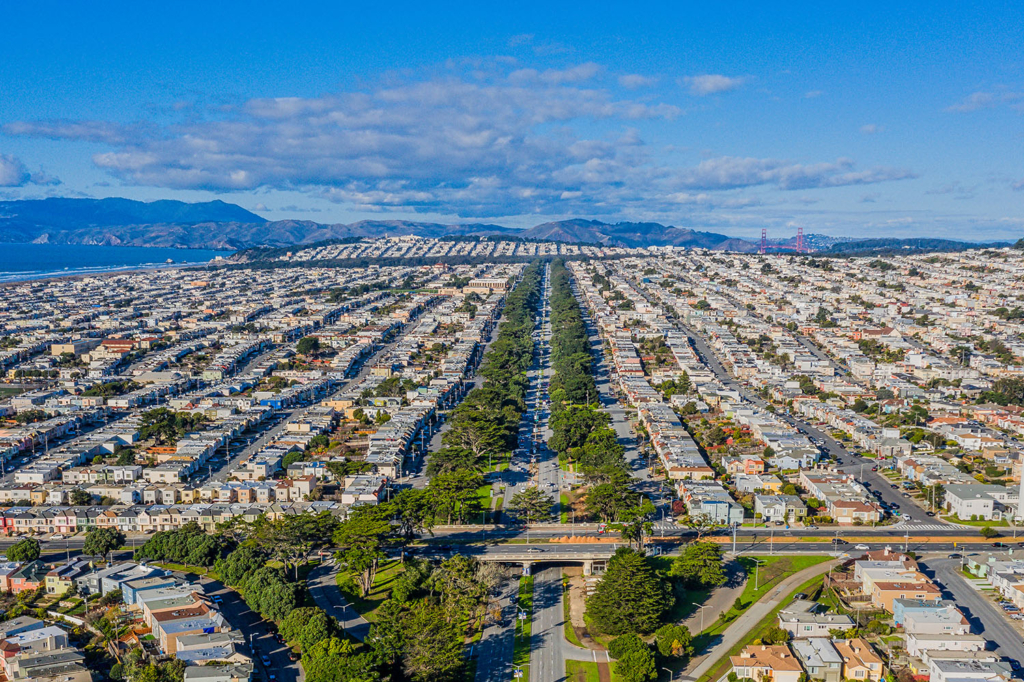
District 2: Sunset
History:
Before the 1900s, the Sunset District was largely sand dunes and considered uninhabitable. After the streetcar lines were built, the area quickly developed and attracted residents looking for affordable, suburban-style homes. Over time, the district grew into a bustling residential area, while still maintaining its quiet, close-knit community feel.
Weather:
The Sunset is famous for its foggy, cooler climate, especially during the summer. However, the fall brings warmer and clearer days, making it a favorite time for locals. The proximity to the ocean means the district stays cool year-round, which many residents love for its refreshing, coastal atmosphere.
Education:
District 2 offers some of the best public schools in the city, making it a popular area for families. Schools like Alice Fong Yu Alternative School with its Cantonese immersion program, and A.P. Giannini Middle School, are highly regarded. Abraham Lincoln High School is the main public high school and is known for its strong academics and diverse student body.
- Private Schools: Though there are fewer private schools here compared to other districts, St. Gabriel School in Parkside is a well-regarded Catholic option.
- Charter/Magnet Schools: District 2 does not have major charter or magnet schools, with the exception of Alice Fong Yu, a public K-8 alternative school known for its language immersion programs.
Grade for Education: A
(Excellent public schools with strong elementary and high school options. Fewer private and charter schools.)
Public Transit, Walkability, and Proximity to Work Hubs:
District 2 is more residential but still well-served by Muni bus lines and the N-Judah and L-Taraval light rail lines. These lines connect to downtown San Francisco and SoMa, making it possible to commute to work hubs, although travel time might be longer. Walkability is better in areas like Inner Sunset, where cafes, restaurants, and shops are within walking distance, but other parts of the district can be more car-dependent.
Work-Life Balance:
District 2 provides an excellent work-life balance, especially for those who love the outdoors. With Golden Gate Park nearby, residents can enjoy jogging, biking, or just relaxing in nature. Ocean Beach is perfect for long walks or surf sessions, while Inner Sunset offers cozy cafes and a laid-back vibe after work. The district’s quieter atmosphere makes it easy to unwind after a busy day in the city.
Did you know?
- Golden Gate Heights is known for its panoramic views, with homes offering some of the best vantage points in the city.
- The Sunset District was originally nothing but sand dunes before development took off in the 1900s.
- Ocean Beach is a top destination for surfers, even though the water is notoriously cold.
Landmarks/Attractions:
- Ocean Beach: A scenic, sprawling beach on the western edge of the city, perfect for long walks, bonfires, and surfing.
- Golden Gate Park: One of San Francisco’s largest parks, offering everything from museums to botanical gardens and outdoor activities.
- 16th Avenue Tiled Steps: A hidden gem in Golden Gate Heights, featuring a colorful mosaic staircase and spectacular views from the top.
Price per sq. ft.: $850 – $1,000 (2024 Q3)
Median price per sq. ft. for condos: $700 – $850
People who live here enjoy the neighborhood because:
District 2 is loved for its peaceful, family-friendly vibe and access to nature. It’s ideal for those who enjoy outdoor activities and prefer quieter, more residential neighborhoods. Families are drawn to the excellent public schools, while professionals appreciate the calm atmosphere and proximity to Ocean Beach and Golden Gate Park. The fall’s sunny weather and the district’s charming streets make it an especially attractive spot.
Subdistricts in District 2:
- Inner Sunset: A lively, walkable area with cozy cafes, shops, and proximity to Golden Gate Park.
- Price per sq. ft.: $900 – $1,050
- Central Sunset: A more residential area with classic Sunset-style homes, offering a quieter, family-friendly atmosphere.
- Price per sq. ft.: $850 – $950
- Outer Sunset: Located closest to the ocean, this neighborhood is foggier but perfect for surfers and those who enjoy a cool coastal climate.
- Price per sq. ft.: $800 – $900
- Inner Parkside: A suburban area with smaller, mid-century homes, offering quiet living with access to schools and parks.
- Price per sq. ft.: $850 – $950
- Central Parkside: A residential neighborhood with a mix of older and newer homes, close to Taraval Street and its shops and dining options.
- Price per sq. ft.: $800 – $900
- Outer Parkside: A foggy, peaceful area, often more affordable, with smaller homes and closer proximity to the ocean.
- Price per sq. ft.: $750 – $850
- Golden Gate Heights: A hillside neighborhood known for its panoramic views and modern homes.
- Price per sq. ft.: $950 – $1,100
Source: Based on real estate market reports for 2024 Q3, provided by local brokerage firms and the San Francisco Association of Realtors®.
District 3: Southwest (Including Lakeshore, Lakeside, Merced Heights, Ingleside, Ingleside Heights, Merced Manor, and Oceanview)
Overview:
District 3 is tucked away in the southwestern corner of San Francisco and includes neighborhoods like Lakeshore, Lakeside, Merced Heights, Ingleside, and Oceanview. This district has a more suburban feel, with larger homes, wider streets, and easy access to green spaces like Lake Merced and San Francisco State University (SFSU). With proximity to Stonestown Galleria, this area offers a balance of peaceful residential living and modern conveniences, making it a great choice for families and professionals who want space without sacrificing access to the city’s amenities.
Architecture:
Homes in District 3 are primarily mid-century style, particularly post-World War II ranch-style houses, and you’ll find many single-family homes built during the 1950s and 1960s. Lakeshore and Lakeside feature larger, more spacious homes, while areas like Merced Heights and Ingleside are known for more modest, cozy houses. Merced Manor offers a more suburban feel, with well-maintained homes that appeal to those seeking a quieter lifestyle.
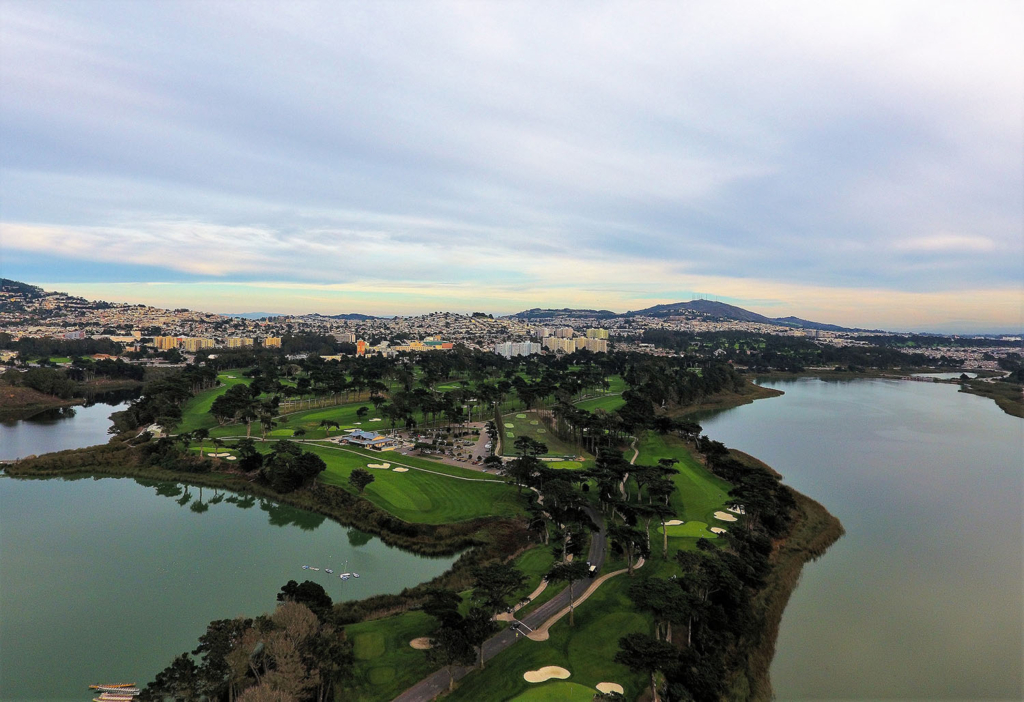
District 3: Southwest
History:
District 3 developed largely after World War II as part of the city’s expansion to the southwest. Originally home to working-class families, this district has grown into a more established residential community. With the development of San Francisco State University and the Stonestown Galleria shopping center, the area became a mix of student-friendly and family-friendly neighborhoods. Over time, it has maintained its suburban charm while continuing to attract new residents.
Weather:
Much like the Sunset District, District 3 tends to be cooler and foggier, especially in the summer. The proximity to the ocean and Lake Merced contributes to the district’s temperate climate, offering cool breezes and overcast skies. Fall brings more sunshine and milder temperatures, making outdoor activities even more enjoyable.
Education:
District 3 is home to one of the city’s top public schools, Lowell High School, which consistently ranks among the best in the state. Families also have access to strong elementary and middle schools like Clarendon Elementary and Commodore Sloat Elementary. Aptos Middle School is another popular option in the area, rounding out the excellent public school offerings.
- Private Schools: While District 3 doesn’t have as many private school options as some other parts of the city, nearby schools like St. Thomas More School provide strong alternatives.
- Charter/Magnet Schools: Creative Arts Charter School, known for its arts-based curriculum, offers a unique option for families looking for something different from the traditional public system.
Grade for Education: A
(Lowell High School is a major draw for families, alongside other strong public schools at the elementary and middle school levels.)
Public Transit, Walkability, and Proximity to Work Hubs:
District 3 is less walkable compared to central parts of San Francisco, but it’s well-served by Muni bus lines and the K-Ingleside light rail. Commuting to work hubs like SoMa or Mission Bay can take longer, but the district’s proximity to San Francisco State University and Lake Merced offers a convenient mix of urban and nature access. The Balboa Park BART station is nearby for easy connections to other parts of the city and the greater Bay Area.
Work-Life Balance:
Living in District 3 offers a quieter, suburban feel without leaving the city. Outdoor enthusiasts love being close to Lake Merced for jogging, cycling, or picnics, while the Stonestown Galleria offers shopping, dining, and even fitness centers. The neighborhood’s calmer atmosphere and open space make it an ideal place for those who want a break from the hustle and bustle of downtown while still enjoying easy access to city amenities.
Did you know?
- Lowell High School is not only one of the top-ranked public high schools in San Francisco but also consistently ranks as one of the best in California.
- Lake Merced is a hidden gem in the southwest part of the city, perfect for outdoor activities like walking, fishing, and bird-watching.
- The Stonestown Galleria shopping center has become a hub for retail, dining, and entertainment in the area, with a wide variety of shops and restaurants.
Landmarks/Attractions:
- Lake Merced: A serene lake surrounded by trails, perfect for outdoor activities like walking, cycling, and fishing.
- San Francisco State University (SFSU): A major educational hub that adds a youthful vibe to the area, along with cultural events and public lectures.
- Stonestown Galleria: A popular shopping destination with a mix of retail stores, restaurants, and entertainment options.
Price per sq. ft.: $700 – $850 (2024 Q3)
Median price per sq. ft. for condos: $600 – $750
People who live here enjoy the neighborhood because:
District 3 is perfect for families and professionals looking for a quieter, suburban lifestyle with access to nature. The peaceful streets, larger homes, and proximity to Lake Merced make it a haven for those who love outdoor activities. Lowell High School is a huge draw for families focused on education, and the nearby Stonestown Galleria provides convenient shopping and dining options.
Subdistricts in District 3:
- Lakeshore: A quieter residential neighborhood near Lake Merced, offering larger homes and proximity to nature.
- Price per sq. ft.: $750 – $850
- Lakeside: Known for its mid-century homes and family-friendly atmosphere, with easy access to Stonestown Galleria and SFSU.
- Price per sq. ft.: $800 – $900
- Merced Manor: A small, suburban-style neighborhood with spacious homes and access to Lake Merced and recreational activities.
- Price per sq. ft.: $800 – $900
- Merced Heights: An elevated neighborhood with great views and more affordable housing options compared to surrounding areas.
- Price per sq. ft.: $700 – $850
- Ingleside: A diverse neighborhood with a mix of older homes and newer constructions, near City College and Balboa Park.
- Price per sq. ft.: $750 – $850
- Ingleside Heights: A more affordable, residential area with a suburban feel and easy access to BART and public transit.
- Price per sq. ft.: $700 – $800
- Oceanview: A quieter, affordable neighborhood with smaller homes and good access to public transit and highways.
- Price per sq. ft.: $700 – $800
Source: Based on real estate market reports for 2024 Q3, provided by local brokerage firms and the San Francisco Association of Realtors®.
District 4: West of Twin Peaks (Including St. Francis Wood, Forest Hill, West Portal, Miraloma Park, and Diamond Heights)
Overview:
District 4 is nestled just west of Twin Peaks and offers a suburban-like atmosphere while still being within the city. The district includes prestigious neighborhoods like St. Francis Wood, Forest Hill, West Portal, Miraloma Park, and Diamond Heights. This area is known for its quiet, tree-lined streets and larger homes, making it a popular destination for families and professionals who want a calm, residential feel. It’s a district filled with parks, easy access to nature, and beautiful homes, with a vibe that’s less urban than many other parts of the city.
Architecture:
District 4 is known for its grand homes, especially in neighborhoods like St. Francis Wood and Forest Hill, where you’ll find Mediterranean Revival, Colonial Revival, and Tudor-style architecture. West Portal has charming single-family homes, often built in the 1920s and 1930s, while Diamond Heights features more modern homes and mid-century condos, often perched on hillsides with sweeping views of the city.
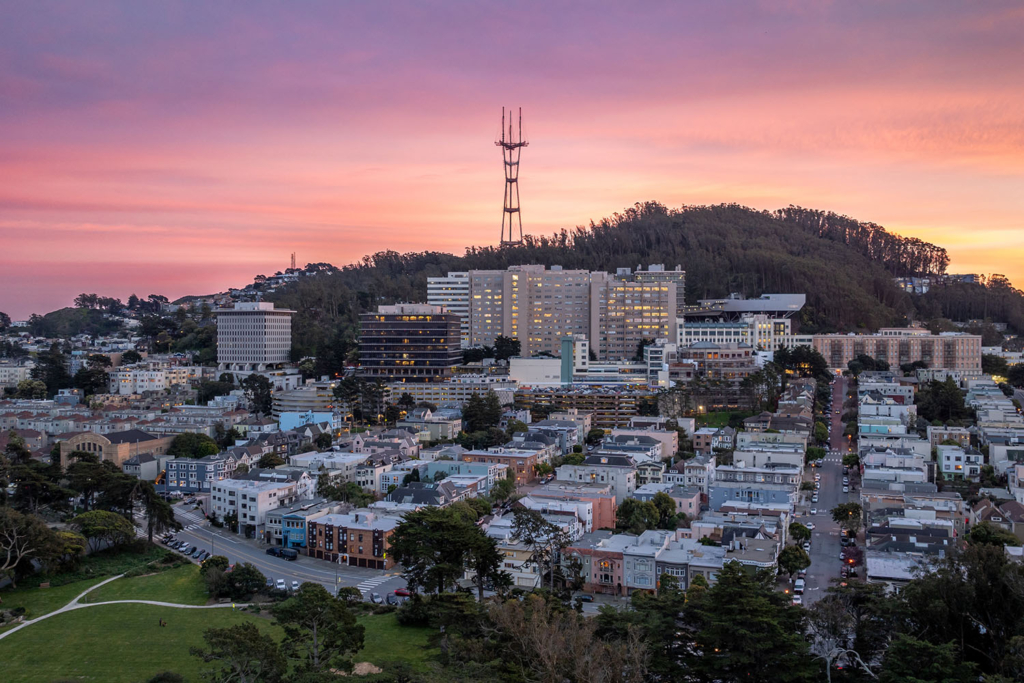
District 4: West of Twin Peaks
History:
The neighborhoods in District 4 were developed in the early 20th century as exclusive, planned communities. St. Francis Wood and Forest Hill were designed for wealthy residents seeking larger homes and suburban-like living within the city. West Portal grew up around the streetcar lines and became a hub for families seeking a quieter area. The district has maintained its upscale, residential charm, with its parks and green spaces offering a peaceful retreat from the city’s busier areas.
Weather:
District 4’s location west of Twin Peaks means it often experiences cooler, foggier weather, especially in the summer. However, its elevated position means that on clear days, the district enjoys beautiful views and sunnier skies, especially in the fall.
Education:
District 4 offers a good mix of public and private schools, with highly regarded elementary schools like West Portal Elementary and Miraloma Elementary. Though there are fewer middle and high school options within the district, nearby schools like Lowell High School and Aptos Middle School are popular choices for families in the area.
- Private Schools: Private school options include St. Brendan School and West Portal Lutheran, both highly regarded for their academic programs.
- Charter/Magnet Schools: There are no major charter or magnet schools in this district.
Grade for Education: A-
(Strong elementary school options with excellent private schools, but fewer middle and high school choices within the district.)
Public Transit, Walkability, and Proximity to Work Hubs:
District 4 is well-served by Muni light rail, especially the K-Ingleside and L-Taraval lines, which run through West Portal, making commuting to downtown relatively easy. While the area isn’t the most walkable, West Portal offers a small commercial center with shops and restaurants, giving it a village-like feel. For professionals, commuting to SoMa or Mission Bay by public transit or car is manageable, though slightly longer compared to more central neighborhoods.
Work-Life Balance:
District 4 is all about balance, offering quiet residential streets, parks, and a slower pace of life. Residents can enjoy hiking in Twin Peaks or Mount Davidson, or stroll through West Portal Avenue to visit local cafes and shops. The district’s laid-back atmosphere makes it a great spot to unwind after a busy day at work, with enough local charm to keep things interesting.
Did you know?
- St. Francis Wood is one of the few neighborhoods in San Francisco with no overhead power lines, adding to its pristine, suburban feel.
- West Portal gets its name from being the western entrance to the Twin Peaks tunnel, connecting the neighborhood to downtown San Francisco.
- Forest Hill is one of the city’s oldest planned communities, known for its lush greenery and large, historic homes.
Landmarks/Attractions:
- Twin Peaks: One of the best spots for panoramic views of the city, with hiking trails and scenic overlooks.
- West Portal Avenue: A charming street with local cafes, restaurants, and boutique shops, giving the area a small-town feel.
- Mount Davidson: The highest point in San Francisco, offering hiking trails and stunning views.
Price per sq. ft.: $1,000 – $1,200 (2024 Q3)
Median price per sq. ft. for condos: $900 – $1,100
People who live here enjoy the neighborhood because:
District 4 attracts families and professionals who want a quieter, more suburban lifestyle without leaving the city. The large homes, peaceful streets, and strong school options make it perfect for those looking for space and serenity. The proximity to nature, along with the charm of neighborhoods like West Portal, gives residents the best of both worlds—city living with a relaxed, residential vibe.
Subdistricts in District 4:
- St. Francis Wood: A prestigious neighborhood with grand homes, known for its landscaped streets and suburban feel.
- Price per sq. ft.: $1,300 – $1,500
- Forest Hill: A lush, tree-filled neighborhood with large, historic homes and a peaceful atmosphere.
- Price per sq. ft.: $1,150 – $1,300
- West Portal: A small, village-like neighborhood with charming homes and a lively commercial strip along West Portal Avenue.
- Price per sq. ft.: $1,000 – $1,200
- Miraloma Park: A quiet, residential area with single-family homes, offering a suburban feel and great access to parks.
- Price per sq. ft.: $950 – $1,100
- Diamond Heights: A hillside neighborhood with mid-century modern homes and condos, offering stunning views of the city and bay.
- Price per sq. ft.: $950 – $1,100
Source: Based on real estate market reports for 2024 Q3, provided by local brokerage firms and the San Francisco Association of Realtors®.
District 5: Central (Including Noe Valley, Castro, Glen Park, and Cole Valley)
Overview:
District 5 is one of the most vibrant parts of San Francisco, home to neighborhoods like Noe Valley, The Castro, Glen Park, and Cole Valley. This area has a fantastic blend of trendy spots and quieter residential streets, making it a favorite for young professionals in tech and healthcare. Known for its cafes, boutiques, and lively atmosphere, District 5 offers great access to both work hubs and some of the city’s best dining and nightlife. Whether you’re relaxing in Dolores Park or enjoying a night out in The Castro, this district has something for everyone.
Architecture:
District 5 showcases a beautiful mix of historic architecture, from the colorful Victorians in Noe Valley and Cole Valley to more modern homes tucked into the hills of Glen Park. The Castro is famous for its charming, colorful homes, while Glen Park has a mix of older and newer homes, many with great views.
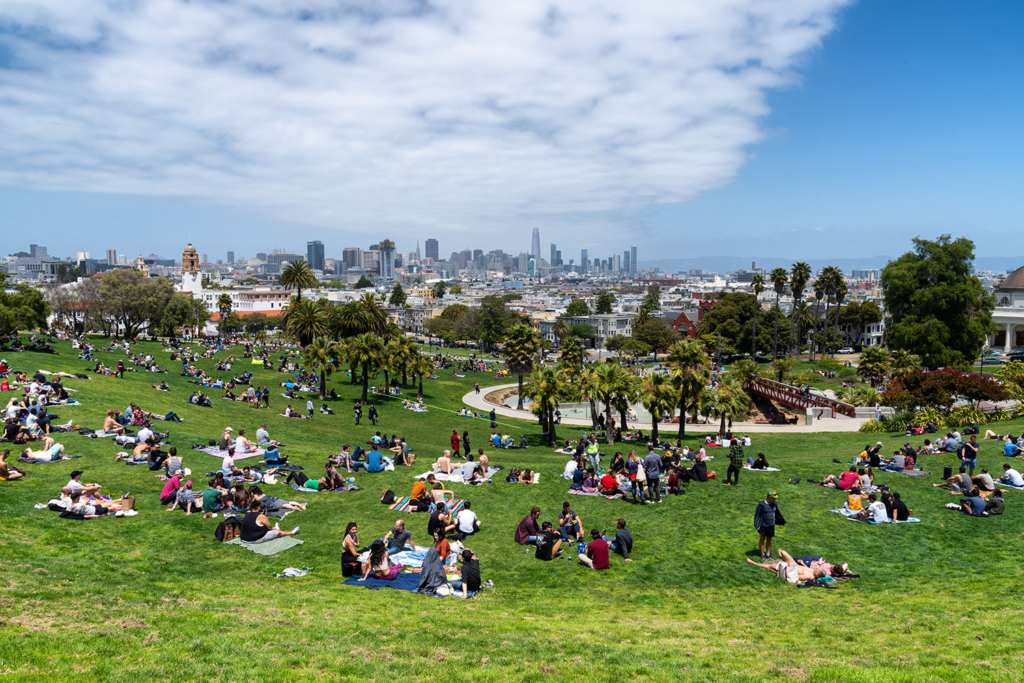
District 5: Central
History:
Each neighborhood in District 5 has a rich history. The Castro is known for its deep roots in activism and history that goes beyond LGBTQ+ culture. Noe Valley and Cole Valley were developed in the late 19th century and have long been popular with families and professionals. Glen Park grew later but retains a quieter, village-like atmosphere that makes it unique within the city.
Weather:
District 5 enjoys some of the best weather in the city, with lots of sunshine and mild temperatures year-round. You’ll find fewer foggy days compared to the western parts of San Francisco, making it perfect for outdoor activities and al fresco dining.
Education:
District 5 offers strong educational options, both public and private. Clarendon Elementary is one of the most sought-after public schools, while Harvey Milk Civil Rights Academy is a standout for its inclusive, community-focused education. Ruth Asawa School of the Arts (SOTA) is a magnet high school that draws students from across the city for its arts programs.
- Private Schools: The Urban School of San Francisco and Synergy School are highly regarded private schools in this district, offering excellent academics.
- Charter/Magnet Schools: Ruth Asawa SOTA is a top magnet school for students interested in the arts, and Gateway Middle School offers a strong college-prep curriculum.
Grade for Education: A
(A mix of excellent public and private options, with standout schools like Ruth Asawa SOTA for specialized arts education.)
Public Transit, Walkability, and Proximity to Work Hubs:
District 5 is highly walkable, especially in neighborhoods like Noe Valley and Castro, where you can find cafes, restaurants, and shops within easy walking distance. The district is well-served by Muni lines, including the J-Church light rail, making commuting to tech hubs in SoMa or Mission Bay easy. The combination of public transit and walkability makes this a great area for car-free living.
Work-Life Balance:
District 5 excels in offering a balanced lifestyle. You can spend your days commuting easily to work hubs and come home to vibrant streets filled with nightlife and dining options. Whether you’re meeting friends at a Noe Valley cafe, relaxing in Dolores Park, or enjoying a night out in The Castro, the neighborhood is packed with things to do. Plus, parks like Glen Canyon provide a quick escape into nature.
Did you know?
- The Castro Theatre was built in 1922 and originally hosted silent films, complete with live orchestral accompaniment.
- Glen Park Canyon was once a rock quarry, and the stone used to build St. John’s Presbyterian Church in Berkeley was quarried from this site.
- Noe Valley is named after José de Jesús Noé, the last Mexican mayor of San Francisco, who was granted this land in 1846 when the area was still part of Mexico.
Landmarks/Attractions:
- Dolores Park: Known for its great views and lively atmosphere, it’s a popular hangout spot for locals.
- The Castro Theatre: A historic landmark and popular movie palace, hosting film festivals and special screenings.
- Glen Canyon Park: A beautiful, tucked-away park perfect for hiking and outdoor adventures.
Price per sq. ft.: $1,200 – $1,400 (2024 Q3)
Median price per sq. ft. for condos: $1,000 – $1,200
People who live here enjoy the neighborhood because:
District 5 is a dream for young professionals who want a balance of work, social life, and easy access to nature. The walkable streets, great dining scene, and proximity to work hubs make it a top choice. The strong public and private school options also make it attractive to families, while the neighborhood’s sunny weather and vibrant culture keep everyone entertained.
Subdistricts in District 5:
- Noe Valley: A family-friendly neighborhood known for its Victorian homes, boutiques, and cafes, often referred to as “Stroller Valley.”
- Price per sq. ft.: $1,250 – $1,450
- Eureka Valley (Castro, Liberty Hill): Vibrant LGBTQ+ community with colorful homes, a rich history, and lively nightlife.
- Price per sq. ft.: $1,200 – $1,400
- Glen Park: A quiet, residential area known for its natural canyon and village-like feel.
- Price per sq. ft.: $1,150 – $1,300
- Cole Valley: A charming, laid-back neighborhood with Edwardian homes, cozy cafes, and a relaxed atmosphere.
- Price per sq. ft.: $1,300 – $1,450
- Corona Heights: A small, hilltop neighborhood with parks and stunning views of the city.
- Price per sq. ft.: $1,150 – $1,300
- Clarendon Heights: An exclusive area offering some of the best views in the city, known for modern homes and winding streets.
- Price per sq. ft.: $1,400 – $1,600
Source: Based on real estate market reports for 2024 Q3, provided by local brokerage firms and the San Francisco Association of Realtors®.
District 6: Central North (Including Hayes Valley, NOPA, Alamo Square, and Western Addition)
Overview:
District 6 is an exciting, central area that includes Hayes Valley, NOPA (North of the Panhandle), Alamo Square, and Western Addition. Known for its trendy boutiques, hip cafes, and vibrant social scene, this district is a favorite among young professionals in tech and healthcare. Hayes Valley is especially popular, with its chic, modern vibe, while Alamo Square offers iconic San Francisco views with its famous Painted Ladies. If you’re looking for a lively neighborhood with plenty of culture, this district is where it’s at.
Architecture:
District 6 has a mix of classic San Francisco Victorians and more modern developments. Alamo Square is home to some of the most photographed houses in the city, while Hayes Valley has seen a lot of new development in recent years, with sleek condos and apartment buildings popping up alongside historic homes.
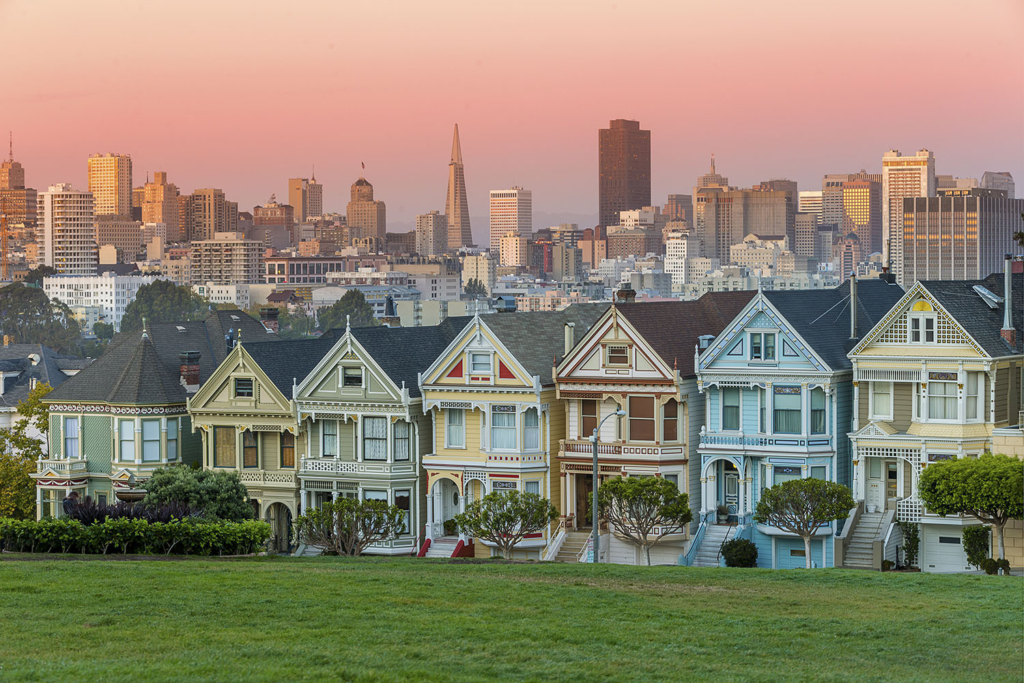
District 6: Central North
History:
This area has long been a cultural hub for San Francisco. Hayes Valley was once an area in transition but has blossomed into one of the city’s trendiest neighborhoods. Alamo Square is famous for the Painted Ladies, a row of Victorian houses that have become an iconic symbol of the city. Western Addition has a rich history as well, originally a neighborhood built for the city’s post-Gold Rush expansion.
Weather:
District 6 enjoys some of the city’s best weather, with more sunny days and fewer foggy mornings compared to the western neighborhoods. The mild temperatures make it easy to enjoy the district’s many outdoor cafes and parks year-round.
Education:
District 6 has improving public school options. John Muir Elementary and Willie L. Brown Jr. Middle School are working to enhance their academic programs, but families often look to nearby schools or opt for private education. Gateway High School is a strong charter option for college prep.
- Private Schools: San Francisco Day School and Schools of the Sacred Heart are standout private schools in the area.
- Charter/Magnet Schools: Gateway High School and Gateway Middle School offer solid college-prep alternatives within the district.
Grade for Education: B+
(Improving public school options and strong private schools, with a few good charter choices.)
Public Transit, Walkability, and Proximity to Work Hubs:
District 6 is extremely walkable, especially in Hayes Valley and NOPA, where cafes, shops, and restaurants are just steps away. The area is well-served by Muni bus and light rail lines, making it easy to commute to SoMa, Downtown, and other work hubs. Hayes Valley is particularly close to the tech and healthcare centers in Mission Bay, making it a convenient choice for professionals.
Work-Life Balance:
District 6 offers an excellent work-life balance. You’re close enough to work hubs to cut down on commute times, and the social scene is buzzing. From trendy bars and cafes in Hayes Valley to cultural hotspots like the San Francisco Symphony and the SFJAZZ Center, there’s always something to do after work. Alamo Square and the Panhandle provide green spaces for relaxing or getting in a quick jog.
Did you know?
- The Hayes Valley neighborhood was transformed after the Central Freeway was torn down in 2003, revitalizing the area into the trendy hotspot it is today.
- The Western Addition was once home to a thriving jazz scene in the 1940s and 1950s, with clubs featuring legends like John Coltrane and Billie Holiday.
- The Painted Ladies of Alamo Square are one of the most photographed sights in the world, with the row of houses featured in movies, postcards, and TV shows.
Landmarks/Attractions:
- Painted Ladies at Alamo Square: One of San Francisco’s most famous sights, these colorful Victorian houses are a must-see.
- SFJAZZ Center: A world-class venue hosting live jazz performances year-round.
- Hayes Street: Known for its boutique shops, trendy cafes, and fantastic restaurants.
Price per sq. ft.: $1,100 – $1,300 (2024 Q3)
Median price per sq. ft. for condos: $950 – $1,100
People who live here enjoy the neighborhood because:
District 6 is perfect for young professionals who want a lively, trendy neighborhood with plenty to do. The great food, fun nightlife, and proximity to work hubs make it an easy choice. Plus, the walkable streets and green spaces like Alamo Square make it a great spot for relaxing and enjoying the city’s iconic views.
Subdistricts in District 6:
- Hayes Valley: A trendy neighborhood with boutiques, restaurants, and a thriving social scene, offering both historic Victorians and modern condos.
- Price per sq. ft.: $1,200 – $1,350
- North of Panhandle (NOPA): A residential area with classic Victorians and Edwardians, known for its proximity to the Panhandle of Golden Gate Park.
- Price per sq. ft.: $1,100 – $1,250
- Alamo Square: Famous for its Painted Ladies and park, this neighborhood offers iconic San Francisco views and historic homes.
- Price per sq. ft.: $1,150 – $1,300
- Western Addition: A diverse neighborhood with a mix of historic and modern homes, undergoing revitalization and offering great access to central San Francisco.
- Price per sq. ft.: $1,000 – $1,150
- Anza Vista: A quiet, residential area with mid-century homes and apartment buildings, located just north of the Western Addition.
- Price per sq. ft.: $1,050 – $1,200
- Lower Pacific Heights: A more affordable, residential alternative to Pacific Heights, offering a mix of older buildings and newer developments.
- Price per sq. ft.: $1,100 – $1,300
Source: Based on real estate market reports for 2024 Q3, provided by local brokerage firms and the San Francisco Association of Realtors®.
District 7: North (Including Pacific Heights, Presidio Heights, Cow Hollow, and Marina)
Overview:
District 7, located in the northern part of San Francisco, is home to some of the city’s most prestigious and affluent neighborhoods, including Pacific Heights, Presidio Heights, Cow Hollow, and the Marina. Known for its luxurious homes, sweeping views of the bay, and vibrant commercial corridors, this district is highly desirable for families, professionals, and those seeking upscale living within the city. With its mix of historic mansions, modern apartments, and proximity to parks and waterfront areas, District 7 offers a blend of urban sophistication and natural beauty.
Architecture:
District 7 is known for its grand, historic homes, particularly in Pacific Heights and Presidio Heights, where many of the city’s wealthiest residents reside. The architecture here includes large, detached mansions in styles ranging from Victorian to Beaux-Arts and Mediterranean Revival. Cow Hollow and the Marina feature a mix of historic and modern apartment buildings, offering a more urban atmosphere with proximity to the bay.
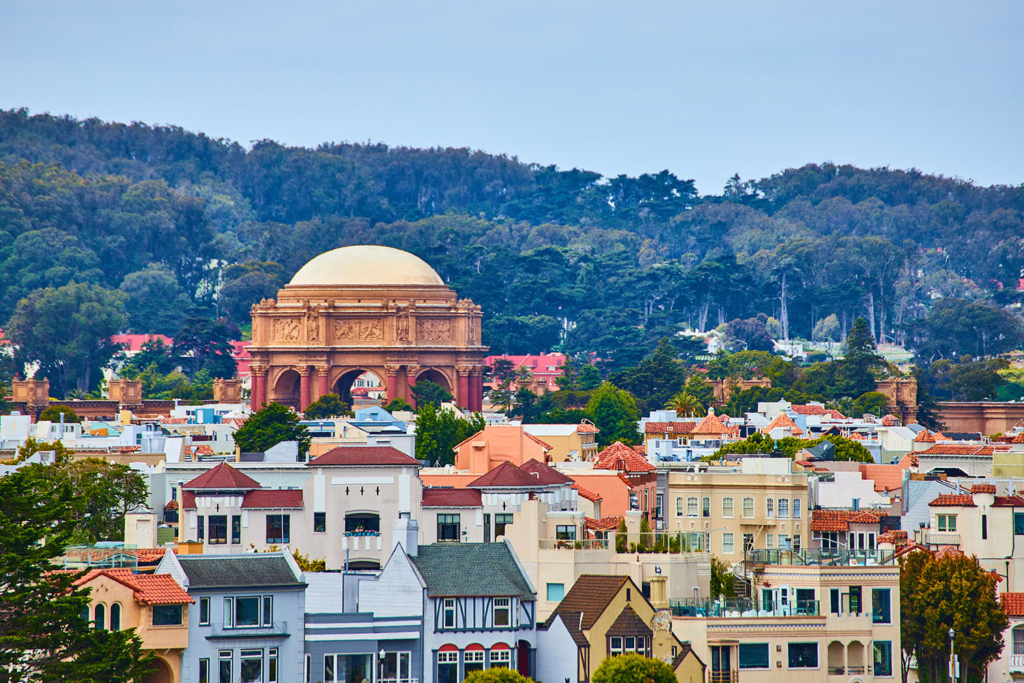
District 7: North
History:
Many of the homes in Pacific Heights and Presidio Heights were built in the late 19th and early 20th centuries by some of San Francisco’s most prominent families. These neighborhoods have long been associated with wealth and prestige, with many of the city’s elite calling the area home. Cow Hollow and the Marina were developed later, with the Marina being built on reclaimed land following the 1915 Panama-Pacific International Exposition.
Weather:
District 7 benefits from its location along the northern waterfront, enjoying more sunshine and fewer foggy days compared to the western parts of the city. The district experiences mild temperatures and clear skies, particularly during the fall.
Education:
District 7 offers a mix of high-quality public and private K-12 schools, though some areas may have fewer public school options. Public school assignments are handled through the SFUSD lottery system, and notable public schools in the area include Claire Lilienthal K-8 and Marina Middle School. However, families in this district often opt for private schooling due to the abundance of prestigious options.
- Private Schools: San Francisco University High School, a top-tier college preparatory school, and Hamlin School, an all-girls school known for academic excellence.
- Charter/Magnet Schools: There are no charter or magnet schools in District 7.
Grade for Education: A-
(Excellent private school options, with fewer notable public schools.)
Public Transit, Walkability, and Proximity to Work Hubs:
District 7 is one of the most walkable districts, especially in Cow Hollow and the Marina, where restaurants, bars, and shops are just steps away. The area is also well-served by Muni bus lines, making it easy to reach downtown and other parts of the city. For professionals, commuting to SoMa or the Financial District is relatively quick and easy, with the Van Ness corridor and Marina Green providing scenic routes.
Work-Life Balance:
District 7 offers an upscale lifestyle with plenty of work-life balance. With easy access to waterfront parks, like Crissy Field and the Presidio, and vibrant nightlife and dining in Cow Hollow and the Marina, it’s perfect for those who want to unwind in style. Whether you’re enjoying a rooftop cocktail with friends or going for a morning run along the water, this district gives residents the best of both city life and natural beauty.
Did you know?
- Pacific Heights was one of the few areas in San Francisco that survived the 1906 earthquake and fire, making it a prime location for wealthy families to rebuild afterward.
- The Marina is built on landfill from the 1915 Panama-Pacific Exposition and was heavily damaged in the 1989 Loma Prieta earthquake.
- Presidio Heights sits on the edge of the Presidio, a former military base that’s now a national park, offering stunning views and hiking trails.
Landmarks/Attractions:
- Crissy Field: A popular waterfront park offering stunning views of the Golden Gate Bridge and access to walking trails, beaches, and picnic areas.
- The Presidio: A historic military base turned national park, offering hiking trails, cultural events, and breathtaking vistas.
- Palace of Fine Arts: An iconic structure originally built for the 1915 Panama-Pacific International Exposition, now a favorite spot for weddings, photography, and events.
Price per sq. ft.: $1,325 – $1,475 (2024 Q3)
Median price per sq. ft. for condos: $1,150 – $1,300
People who live here enjoy the neighborhood because:
District 7 appeals to affluent families, professionals, and those who value luxury living and proximity to cultural and natural attractions. The area’s prestigious homes, access to parks, and high-end shopping and dining make it a popular choice for residents who enjoy an upscale lifestyle. Families appreciate the excellent private school options, while professionals are drawn to the district’s scenic views, proximity to the waterfront, and easy access to downtown San Francisco.
Subdistricts in District 7:
- Pacific Heights: A prestigious neighborhood known for its grand homes, sweeping views, and access to luxury shopping and dining.
- Price per sq. ft.: $1,400 – $1,500
- Presidio Heights: A serene, upscale area adjacent to the Presidio, offering larger homes and easy access to nature.
- Price per sq. ft.: $1,350 – $1,475
- Cow Hollow: A lively neighborhood with a mix of historic and modern homes, known for its restaurants, nightlife, and proximity to the waterfront.
- Price per sq. ft.: $1,300 – $1,400
- Marina District: A vibrant, waterfront neighborhood with a mix of Art Deco and modern homes, popular for its scenic views and bustling atmosphere.
- Price per sq. ft.: $1,275 – $1,350
Source: Based on real estate market reports for 2024 Q3, provided by local brokerage firms and the San Francisco Association of Realtors®.
District 8: Northeast (Including Russian Hill, Nob Hill, Telegraph Hill, North Beach, Financial District, and Downtown)
Overview:
District 8 is the heartbeat of San Francisco’s iconic skyline, encompassing the areas of Russian Hill, Nob Hill, Telegraph Hill, North Beach, Financial District, and Downtown. These neighborhoods blend San Francisco’s history with modern living, offering stunning views, historic landmarks, and the city’s top financial and cultural centers. From the charming, European-style streets of North Beach to the urban energy of Downtown, District 8 is perfect for those who want to live in the middle of it all.
Architecture:
District 8 is home to some of the most famous buildings in San Francisco, with a mix of historic architecture and modern high-rises. Russian Hill and Nob Hill boast classic Victorian and Edwardian homes, while the Financial District and Downtown offer towering skyscrapers and luxury condos. Telegraph Hill is famous for its steep streets and Coit Tower, while North Beach retains its old-world charm with Mediterranean-style buildings.
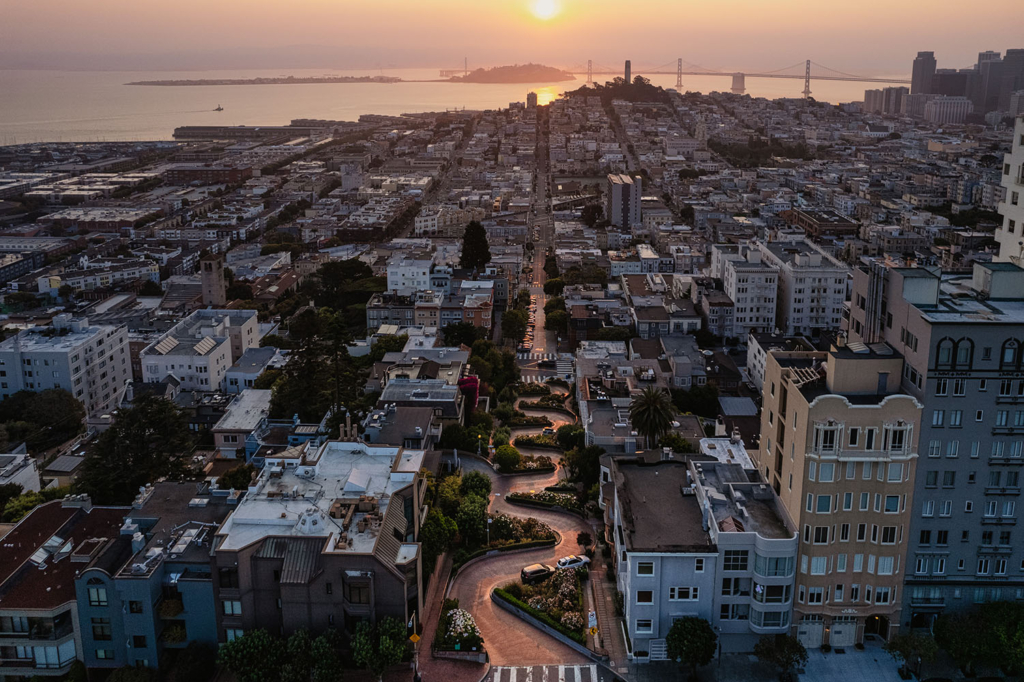
District 8: Northeast
History:
District 8 has deep historical roots, from the Gold Rush days to the city’s rise as a financial powerhouse. Nob Hill was home to the city’s wealthy industrialists, known as the “Big Four,” who built their mansions there in the late 19th century. Telegraph Hill was one of the first signal points in the city, while North Beach has long been the heart of San Francisco’s Italian-American community.
Weather:
Due to its location, District 8 enjoys some of the city’s best weather. With fewer foggy days than the western districts and mild temperatures year-round, this area is great for those who enjoy outdoor activities, dining al fresco, and exploring the city’s many parks and attractions.
Education:
District 8 has fewer public school options compared to other districts, with most families opting for private education. However, notable public schools include Spring Valley Science Elementary and Galileo High School, which are popular among residents.
- Private Schools: San Francisco Day School and Convent & Stuart Hall are prestigious private schools in the area.
- Charter/Magnet Schools: There are no significant charter or magnet schools in District 8.
Grade for Education: B
(Strong private school options, but limited public school choices within the district.)
Public Transit, Walkability, and Proximity to Work Hubs:
District 8 is one of the most walkable parts of San Francisco, with easy access to the BART and Muni systems. For those working in the Financial District or SoMa, commuting is a breeze. The area is also home to the city’s cable cars, adding a historic touch to public transportation. With everything from restaurants to grocery stores within walking distance, it’s an ideal location for those who prefer to live without a car.
Work-Life Balance:
Living in District 8 offers unparalleled access to the city’s cultural and financial heart. Whether you’re enjoying a night out in North Beach, grabbing a coffee on Nob Hill, or working in the Financial District, there’s always something to do. With parks like Washington Square and the iconic Coit Tower, residents can easily balance work and relaxation, making this district one of the most dynamic in the city.
Did you know?
- Nob Hill got its name from the “nobs,” a term used for wealthy, influential people who lived there in the late 1800s.
- Coit Tower was funded by Lillie Hitchcock Coit, a wealthy philanthropist who left money to beautify San Francisco. She was also a volunteer firefighter, which is why the tower resembles a firehose nozzle.
- North Beach was once home to the famous Beat Generation writers, including Jack Kerouac and Allen Ginsberg, and still has remnants of its literary past today.
Landmarks/Attractions:
- Coit Tower: An iconic San Francisco landmark atop Telegraph Hill, offering panoramic views of the city and the bay.
- Lombard Street: Known as “the crookedest street in the world,” this famous stretch of Russian Hill is a must-see.
- Washington Square Park: A central gathering spot in North Beach, surrounded by cafes and restaurants, offering a slice of greenery in the city.
Price per sq. ft.: $1,200 – $1,400 (2024 Q3)
Median price per sq. ft. for condos: $1,000 – $1,200
People who live here enjoy the neighborhood because:
District 8 is perfect for those who want to live in the cultural and financial heart of the city. Professionals love the easy commute to work, while residents enjoy the rich history, bustling nightlife, and scenic views. Whether you’re drawn to the urban energy of Downtown or the charm of North Beach, there’s always something happening in District 8.
Subdistricts in District 8:
- Russian Hill: A historic neighborhood known for its steep streets, Victorian homes, and stunning views of the bay.
- Price per sq. ft.: $1,250 – $1,400
- Nob Hill: An affluent area with luxury condos and historic mansions, offering some of the best views in the city.
- Price per sq. ft.: $1,300 – $1,450
- Telegraph Hill: A charming neighborhood known for its steep hills, classic architecture, and Coit Tower.
- Price per sq. ft.: $1,200 – $1,400
- North Beach: A vibrant, Italian-influenced neighborhood with cafes, restaurants, and a lively nightlife scene.
- Price per sq. ft.: $1,150 – $1,300
- Financial District: The city’s financial hub, home to skyscrapers, luxury condos, and a fast-paced urban environment.
- Price per sq. ft.: $1,350 – $1,500
- Downtown: A bustling area with a mix of historic buildings and modern high-rises, offering easy access to the city’s main attractions.
- Price per sq. ft.: $1,300 – $1,450
- Van Ness/Civic Center: Known for its cultural institutions, including the San Francisco Opera and City Hall, with a mix of residential and commercial spaces.
- Price per sq. ft.: $1,150 – $1,300
- Tenderloin: A diverse, urban neighborhood with affordable housing and an eclectic mix of shops and restaurants.
- Price per sq. ft.: $950 – $1,150
Source: Based on real estate market reports for 2024 Q3, provided by local brokerage firms and the San Francisco Association of Realtors®.
District 9: Southeast (Including SoMa, South Beach, Mission Bay, Potrero Hill, Dogpatch, Bernal Heights, Inner Mission, and Yerba Buena)
Overview:
District 9 is one of the most diverse and rapidly changing areas of San Francisco, encompassing neighborhoods like SoMa (South of Market), South Beach, Mission Bay, Potrero Hill, Dogpatch, Bernal Heights, and the Inner Mission. Known for its mix of industrial roots, modern developments, and historic charm, District 9 has become a hotspot for young professionals, tech workers, and those looking to be part of the city’s most dynamic neighborhoods. With its trendy restaurants, burgeoning arts scene, and proximity to work hubs like Mission Bay and Downtown, this district is a vibrant mix of old and new.
Architecture:
District 9 features a wide range of architectural styles, from sleek, modern high-rises in SoMa and Mission Bay to charming Victorian and Edwardian homes in Bernal Heights and the Inner Mission. Dogpatch and Potrero Hill have maintained much of their industrial feel, with warehouses converted into lofts and modern developments popping up alongside historic homes.

District 9: Southeast
History:
Many of the neighborhoods in District 9 have deep industrial roots, particularly Dogpatch and SoMa, which were once home to factories and shipping yards. In recent years, the district has undergone significant transformation, with new developments in Mission Bay and the rise of tech companies in SoMa. The Mission is one of the oldest neighborhoods in San Francisco, originally established by Spanish missionaries in the late 1700s, and it remains a cultural center for the city’s Latino community.
Weather:
District 9 enjoys some of the best weather in the city, with more sunshine and fewer foggy days compared to the western neighborhoods. The warmer microclimate makes it a popular spot for outdoor activities, dining, and festivals.
Education:
District 9 has a mix of public and private schools, though the area’s rapid growth has put pressure on the school system. Public schools like Buena Vista Horace Mann K-8 offer bilingual education programs, while private schools such as Live Oak School provide strong alternatives. Mission Preparatory is a notable charter school in the area.
- Private Schools: Live Oak School and Synergy School offer excellent private education options in the district.
- Charter/Magnet Schools: Mission Preparatory Charter School is a standout option for families seeking a strong academic environment.
Grade for Education: B+
(Improving public school options, strong private and charter school choices, but increasing demand due to neighborhood growth.)
Public Transit, Walkability, and Proximity to Work Hubs:
District 9 is well-connected by public transit, with BART, Muni, and Caltrain offering easy access to the rest of the city and the greater Bay Area. SoMa, Mission Bay, and South Beach are particularly popular among professionals working in tech and healthcare, due to their proximity to the city’s major work hubs. Walkability is excellent in neighborhoods like Mission Bay, Potrero Hill, and the Inner Mission, where cafes, shops, and restaurants are just steps away.
Work-Life Balance:
Living in District 9 provides the perfect blend of work and play. Residents can easily commute to tech companies in SoMa and Mission Bay while enjoying an active social life in the evenings. Whether you’re grabbing dinner at a trendy spot in the Mission, attending an art exhibit in Dogpatch, or taking a walk through Bernal Heights Park, this district has no shortage of things to do. The diverse neighborhoods and lively atmosphere make it a popular choice for those seeking a vibrant, urban lifestyle.
Did you know?
- Dogpatch is one of San Francisco’s oldest neighborhoods, and many of the buildings predate the 1906 earthquake, making it one of the few areas that survived the disaster.
- SoMa (South of Market) was once an industrial area but is now home to some of the biggest tech companies in the world, including Salesforce.
- Mission Dolores is the oldest surviving structure in San Francisco, built in 1791 as part of the Spanish mission system.
Landmarks/Attractions:
- Mission Dolores Park: A beloved gathering spot for locals, offering great views of the city and plenty of room for picnics and outdoor activities.
- Oracle Park: Home to the San Francisco Giants, this waterfront stadium offers stunning views and is a favorite spot for baseball fans.
- The Lab: A longstanding arts space in Dogpatch known for avant-garde performances and exhibits.
Price per sq. ft.: $1,000 – $1,200 (2024 Q3)
Median price per sq. ft. for condos: $900 – $1,050
People who live here enjoy the neighborhood because:
District 9 is perfect for young professionals, tech workers, and families who love a lively, culturally rich neighborhood. With its diverse architecture, vibrant food scene, and proximity to work hubs like Mission Bay and SoMa, District 9 is ideal for those who want to live in one of the city’s most dynamic and rapidly growing areas.
Subdistricts in District 9:
- SoMa (South of Market): A rapidly developing neighborhood with modern high-rises, tech offices, and a lively nightlife scene.
- Price per sq. ft.: $1,050 – $1,250
- South Beach: A waterfront neighborhood with luxury condos, offering stunning views and proximity to Oracle Park and the Embarcadero.
- Price per sq. ft.: $1,100 – $1,250
- Mission Bay: A tech and healthcare hub, known for its modern high-rises and proximity to the waterfront and UCSF.
- Price per sq. ft.: $1,000 – $1,200
- Potrero Hill: A residential neighborhood known for its charming homes, sunny weather, and great views of the city and bay.
- Price per sq. ft.: $1,050 – $1,200
- Dogpatch: An industrial-chic neighborhood with historic buildings, art spaces, and trendy new developments.
- Price per sq. ft.: $1,000 – $1,150
- Bernal Heights: A hillside neighborhood with a mix of historic homes and modern renovations, offering some of the best views in the city.
- Price per sq. ft.: $1,050 – $1,200
- Inner Mission: A vibrant, historic neighborhood known for its Latino culture, street art, and fantastic restaurants.
- Price per sq. ft.: $950 – $1,100
- Yerba Buena: A small, cultural hub near SoMa, with museums, galleries, and a growing residential community.
- Price per sq. ft.: $1,050 – $1,200
Source: Based on real estate market reports for 2024 Q3, provided by local brokerage firms and the San Francisco Association of Realtors®.
District 10: Southeast (Including Bayview, Excelsior, Visitacion Valley, Portola, Crocker Amazon, and Outer Mission)
Overview:
District 10, located in the southeastern corner of San Francisco, includes neighborhoods like Bayview, Excelsior, Visitacion Valley, Portola, Crocker Amazon, and Outer Mission. Known for its affordability compared to other parts of the city, District 10 is one of the fastest-growing areas, attracting first-time homebuyers, young professionals, and families looking for more space. With an up-and-coming arts scene, new developments, and easy access to freeways, District 10 offers a lot of potential for those seeking to be part of the city’s evolving neighborhoods.
Architecture:
District 10 features a mix of classic San Francisco homes and newer developments. In neighborhoods like Bayview and Excelsior, you’ll find charming, single-family homes built in the 1930s and 1940s, while Visitacion Valley and Crocker Amazon offer a combination of older homes and newer condominiums. Portola is known for its Mediterranean-style homes and tree-lined streets, providing a quaint suburban feel within the city.
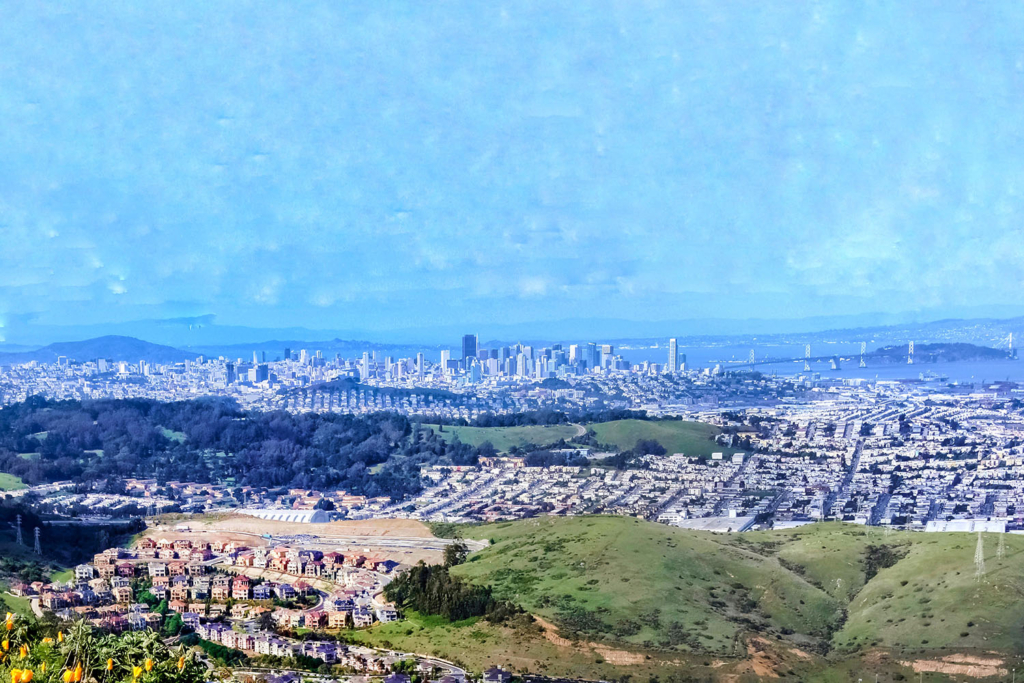
District 10: Southeast
History:
Many of the neighborhoods in District 10 have historically been working-class communities. Bayview was once home to shipyards and factories, while Excelsior and Visitacion Valley attracted immigrant families seeking affordable housing. Over the past decade, the district has seen significant development, with new housing, community spaces, and businesses popping up, particularly in Bayview and Portola.
Weather:
District 10 enjoys some of the warmest weather in San Francisco, thanks to its southeastern location. With fewer foggy days and more sunshine than the western parts of the city, this district is perfect for those who prefer a warmer, sunnier climate.
Education:
District 10 has a range of public and private schools, though some families may look to neighboring districts for additional options. Phillip and Sala Burton High School and Thurgood Marshall High School are notable public schools, and the district also offers a number of charter schools, including Leadership High School.
- Private Schools: Options are limited within the district, but nearby districts provide access to more prestigious private schools.
- Charter/Magnet Schools: Leadership High School and Gateway to College Academy are standout charter schools in the area, offering alternative education programs.
Grade for Education: B
(District 10 has a mix of improving public schools and alternative education options, but some families may choose schools in nearby districts.)
Public Transit, Walkability, and Proximity to Work Hubs:
District 10 is well-connected by public transit, with BART stations in Glen Park and Balboa Park, along with multiple Muni bus lines. The district offers easy access to highways like 101 and 280, making it a popular choice for commuters working in the South Bay or Peninsula. While some neighborhoods, like Portola, have local shopping and dining, other areas are more car-dependent, especially for accessing major work hubs.
Work-Life Balance:
District 10 offers an affordable lifestyle compared to other parts of San Francisco, making it attractive for families and first-time homebuyers. Residents enjoy community-focused living, with parks like McLaren Park providing plenty of outdoor recreation. The district’s growing arts scene, particularly in Bayview, adds a creative flair, while easy access to highways makes it convenient for those commuting outside the city.
Did you know?
- Bayview-Hunters Point was once home to one of the largest shipyards in the U.S. during World War II, contributing to the area’s industrial heritage.
- Visitacion Valley was once the site of Visitacion Ranch, a massive dairy farm that supplied milk to the city in the late 1800s.
- Crocker Amazon Park is one of the largest parks in San Francisco, offering everything from sports fields to playgrounds, making it a community hub for residents.
Landmarks/Attractions:
- McLaren Park: The second-largest park in San Francisco, offering hiking trails, a golf course, and scenic vistas.
- Bayview Opera House: A historic cultural center and community space in Bayview that has hosted events since the late 1800s.
- John McLaren Park Amphitheater: Known for live performances and outdoor concerts, this park feature is a hidden gem in District 10.
Price per sq. ft.: $750 – $950 (2024 Q3)
Median price per sq. ft. for condos: $650 – $850
People who live here enjoy the neighborhood because:
District 10 appeals to families, first-time homebuyers, and professionals looking for more affordable housing and space compared to other parts of San Francisco. The community-focused atmosphere, warm weather, and growing arts scene, particularly in Bayview, make it a great district for those seeking a vibrant yet laid-back lifestyle. Residents also enjoy the convenience of easy freeway access for commutes outside the city.
Subdistricts in District 10:
- Bayview: A historically industrial neighborhood now seeing revitalization, known for its strong sense of community and developing arts scene.
- Price per sq. ft.: $750 – $900
- Excelsior: A diverse, working-class neighborhood with a mix of older homes and a growing number of new developments.
- Price per sq. ft.: $800 – $950
- Visitacion Valley: A residential neighborhood with a suburban feel, offering a combination of older homes and new condos.
- Price per sq. ft.: $700 – $850
- Portola: Known for its Mediterranean-style homes and small-town atmosphere, this neighborhood offers a charming escape within the city.
- Price per sq. ft.: $750 – $950
- Crocker Amazon: A family-friendly area with a mix of mid-century homes, parks, and easy access to highways.
- Price per sq. ft.: $700 – $850
- Outer Mission: A quieter, residential neighborhood with affordable housing options and proximity to Daly City.
- Price per sq. ft.: $700 – $850
Source: Based on real estate market reports for 2024 Q3, provided by local brokerage firms and the San Francisco Association of Realtors®.

